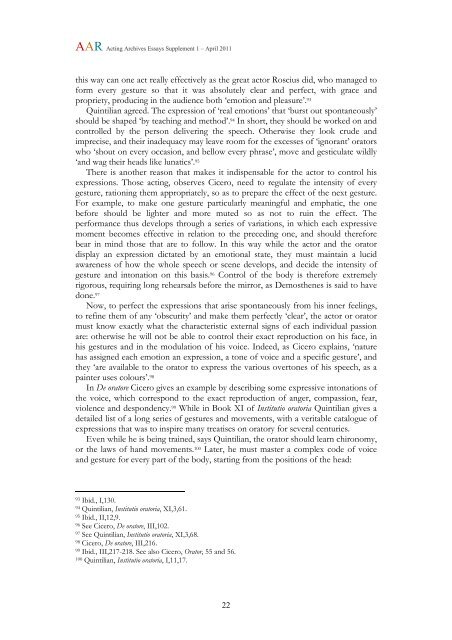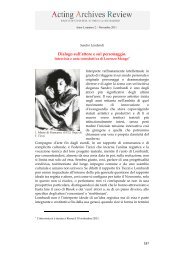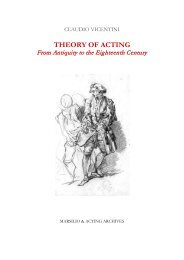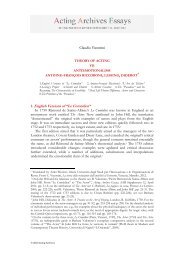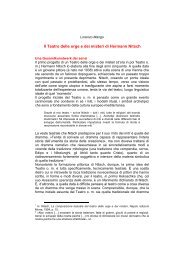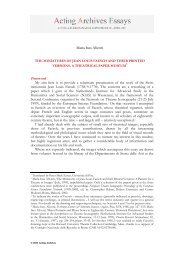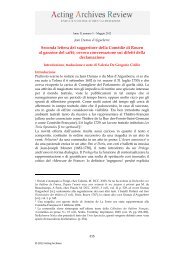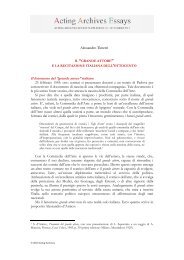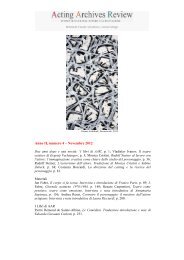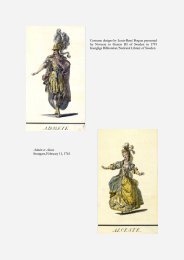AAR <strong>Act<strong>in</strong>g</strong> <strong>Archives</strong> Essays Supplement 1 – April 2011this way can one act really effectively as <strong>the</strong> great actor Roscius did, who managed toform every gesture so that it was absolutely clear and perfect, with grace andpropriety, produc<strong>in</strong>g <strong>in</strong> <strong>the</strong> audience both ‘emotion and pleasure’. 93Qu<strong>in</strong>tilian agreed. The expression of ‘real emotions’ that ‘burst out spontaneously’should be shaped ‘by teach<strong>in</strong>g and method’. 94 In short, <strong>the</strong>y should be worked on andcontrolled by <strong>the</strong> person deliver<strong>in</strong>g <strong>the</strong> speech. O<strong>the</strong>rwise <strong>the</strong>y look crude andimprecise, and <strong>the</strong>ir <strong>in</strong>adequacy may leave room for <strong>the</strong> excesses of ‘ignorant’ oratorswho ‘shout on every occasion, and bellow every phrase’, move and gesticulate wildly‘and wag <strong>the</strong>ir heads like lunatics’. 95There is ano<strong>the</strong>r reason that makes it <strong>in</strong>dispensable for <strong>the</strong> actor to control hisexpressions. Those act<strong>in</strong>g, observes Cicero, need to regulate <strong>the</strong> <strong>in</strong>tensity of everygesture, ration<strong>in</strong>g <strong>the</strong>m appropriately, so as to prepare <strong>the</strong> effect of <strong>the</strong> next gesture.For example, to make one gesture particularly mean<strong>in</strong>gful and emphatic, <strong>the</strong> onebefore should be lighter and more muted so as not to ru<strong>in</strong> <strong>the</strong> effect. Theperformance thus develops through a series of variations, <strong>in</strong> which each expressivemoment becomes effective <strong>in</strong> relation to <strong>the</strong> preced<strong>in</strong>g one, and should <strong>the</strong>reforebear <strong>in</strong> m<strong>in</strong>d those that are to follow. In this way while <strong>the</strong> actor and <strong>the</strong> oratordisplay an expression dictated by an emotional state, <strong>the</strong>y must ma<strong>in</strong>ta<strong>in</strong> a lucidawareness of how <strong>the</strong> whole speech or scene develops, and decide <strong>the</strong> <strong>in</strong>tensity ofgesture and <strong>in</strong>tonation on this basis. 96 Control of <strong>the</strong> body is <strong>the</strong>refore extremelyrigorous, requir<strong>in</strong>g long rehearsals before <strong>the</strong> mirror, as Demos<strong>the</strong>nes is said to havedone. 97Now, to perfect <strong>the</strong> expressions that arise spontaneously from his <strong>in</strong>ner feel<strong>in</strong>gs,to ref<strong>in</strong>e <strong>the</strong>m of any ‘obscurity’ and make <strong>the</strong>m perfectly ‘clear’, <strong>the</strong> actor or oratormust know exactly what <strong>the</strong> characteristic external signs of each <strong>in</strong>dividual passionare: o<strong>the</strong>rwise he will not be able to control <strong>the</strong>ir exact reproduction on his face, <strong>in</strong>his gestures and <strong>in</strong> <strong>the</strong> modulation of his voice. Indeed, as Cicero expla<strong>in</strong>s, ‘naturehas assigned each emotion an expression, a tone of voice and a specific gesture’, and<strong>the</strong>y ‘are available to <strong>the</strong> orator to express <strong>the</strong> various overtones of his speech, as apa<strong>in</strong>ter uses colours’. 98In De oratore Cicero gives an example by describ<strong>in</strong>g some expressive <strong>in</strong>tonations of<strong>the</strong> voice, which correspond to <strong>the</strong> exact reproduction of anger, compassion, fear,violence and despondency. 99 While <strong>in</strong> Book XI of Institutio oratoria Qu<strong>in</strong>tilian gives adetailed list of a long series of gestures and movements, with a veritable catalogue ofexpressions that was to <strong>in</strong>spire many treatises on oratory for several centuries.Even while he is be<strong>in</strong>g tra<strong>in</strong>ed, says Qu<strong>in</strong>tilian, <strong>the</strong> orator should learn chironomy,or <strong>the</strong> laws of hand movements. 100 Later, he must master a complex code of voiceand gesture for every part of <strong>the</strong> body, start<strong>in</strong>g from <strong>the</strong> positions of <strong>the</strong> head:93 Ibid., I,130.94 Qu<strong>in</strong>tilian, Institutio oratoria, XI,3,61.95 Ibid., II,12,9.96 See Cicero, De oratore, III,102.97 See Qu<strong>in</strong>tilian, Institutio oratoria, XI,3,68.98 Cicero, De oratore, III,216.99 Ibid., III,217-218. See also Cicero, Orator, 55 and 56.100 Qu<strong>in</strong>tilian, Institutio oratoria, I,11,17.22
<strong>Claudio</strong> <strong>Vicent<strong>in</strong>i</strong>, <strong>Act<strong>in</strong>g</strong> <strong>Theory</strong> <strong>in</strong> <strong>the</strong> <strong>Ancient</strong> <strong>World</strong>Seemly postures <strong>in</strong>clude first of all keep<strong>in</strong>g <strong>the</strong> head erect and <strong>in</strong> a natural position, aswhen it hangs down it suggests humility, when it is thrown back arrogance, when<strong>in</strong>cl<strong>in</strong>ed to one side languor, when it too stiff and rigid a brutal nature. 101But <strong>the</strong> greatest expressive ability lies <strong>in</strong> <strong>the</strong> face: <strong>the</strong> eyes, <strong>the</strong> cheeks, <strong>the</strong> lips, <strong>the</strong>nostrils and even <strong>the</strong> eyebrows, which <strong>in</strong>dicate anger when <strong>the</strong>y are ‘knitted’, sadnesswhen ‘lowered’, and joy when ‘extended’. Qu<strong>in</strong>tilian <strong>the</strong>n proceeds to shoulders,arms, feet, hands and f<strong>in</strong>gers, <strong>in</strong>dicat<strong>in</strong>g all <strong>the</strong> appropriate movements down to <strong>the</strong>least detail.If one gently takes <strong>the</strong> last jo<strong>in</strong>t of <strong>the</strong> <strong>in</strong>dex f<strong>in</strong>ger on both sides, with <strong>the</strong> o<strong>the</strong>r twof<strong>in</strong>gers slightly crooked, but <strong>the</strong> little f<strong>in</strong>ger less so, <strong>the</strong> result is a gesture suitable forargument. Yet one has <strong>the</strong> impression that someone is discuss<strong>in</strong>g more animatedly if heholds <strong>the</strong> middle jo<strong>in</strong>t of <strong>the</strong> f<strong>in</strong>ger and contract<strong>in</strong>g <strong>the</strong> last two f<strong>in</strong>gers still fur<strong>the</strong>r tomatch <strong>the</strong> lower position of <strong>the</strong> middle f<strong>in</strong>ger and thumb. […] The hand slightlyhollowed as when someone makes a vow, and <strong>the</strong>n moved slightly to and fro, <strong>the</strong>shoulders sway<strong>in</strong>g <strong>in</strong> unison, is particularly suitable for someone express<strong>in</strong>g reluctanceand timidity. A gesture that expresses wonder consists <strong>in</strong> turn<strong>in</strong>g <strong>the</strong> palm of <strong>the</strong> handslightly upwards, br<strong>in</strong>g<strong>in</strong>g each f<strong>in</strong>ger <strong>in</strong> turn <strong>in</strong>to <strong>the</strong> palm, start<strong>in</strong>g from <strong>the</strong> littlef<strong>in</strong>ger, <strong>the</strong>n, while <strong>the</strong> f<strong>in</strong>gers are returned to <strong>the</strong>ir previous position, open<strong>in</strong>g it and at<strong>the</strong> same time turn<strong>in</strong>g it <strong>in</strong> <strong>the</strong> o<strong>the</strong>r direction. 102In <strong>the</strong> meticulous description of all <strong>the</strong>se movements, <strong>the</strong> search for maximumexpressiveness is associated with <strong>the</strong> need for precise stylization that can confer on<strong>the</strong> orator’s action not only decorum, but also <strong>the</strong> grace and beauty that will give <strong>the</strong>audience an <strong>in</strong>dispensable ‘delight’.Specialists forbid <strong>the</strong> hand to be higher than <strong>the</strong> eyes and lower than <strong>the</strong> chest; it isseen as still worse to move it downwards, start<strong>in</strong>g from <strong>the</strong> head, or let it descendbeyond <strong>the</strong> lower belly. The hand should be allowed to rise towards <strong>the</strong> left, but notbeyond <strong>the</strong> shoulder, fur<strong>the</strong>r than that is not proper […] It is never correct togesticulate with <strong>the</strong> left hand alone […] Stand<strong>in</strong>g with <strong>the</strong> right foot and right handforward is ugly. 10311. Possibility of an Anti-Emotional <strong>Theory</strong><strong>Act<strong>in</strong>g</strong> <strong>in</strong> front of an audience, <strong>the</strong>n, comb<strong>in</strong>es two k<strong>in</strong>ds of behaviour. One isspontaneous, lett<strong>in</strong>g face and gestures display what it simply dictated by <strong>the</strong>emotions, and one is conscious and regulated, adopt<strong>in</strong>g gestures and movements thathave been studied and catalogued, both to make <strong>the</strong> expressions more <strong>in</strong>cisive and togive <strong>the</strong>m a special grace and beauty. Los<strong>in</strong>g <strong>the</strong> delicate balance between <strong>the</strong>se twoforms of behaviour would run <strong>the</strong> risk of a crude and overexcited performance, orone that was cold and artificial. And this is <strong>the</strong> explicit position of <strong>the</strong> treatises ofCicero and Qu<strong>in</strong>tilian.However, <strong>the</strong> possibility of codify<strong>in</strong>g <strong>the</strong> expressive signs of <strong>the</strong> various passions,<strong>in</strong>dicat<strong>in</strong>g <strong>the</strong>m down to <strong>the</strong> last detail, as <strong>in</strong> Qu<strong>in</strong>tilian’s pa<strong>in</strong>stak<strong>in</strong>g catalogue,opened ano<strong>the</strong>r path. By long-practised technique <strong>the</strong> actor or orator might try to101 Ibid., XI,3,69.102 Ibid., XI,3,95 and 100.103 Ibid., XI,3,112-114 and 124.23
- Page 1 and 2: Claudio VicentiniTHEORY OF ACTINGIA
- Page 3 and 4: Claudio Vicentini, Acting Theory in
- Page 5 and 6: Claudio Vicentini, Acting Theory in
- Page 7 and 8: Claudio Vicentini, Acting Theory in
- Page 9 and 10: Claudio Vicentini, Acting Theory in
- Page 11 and 12: Claudio Vicentini, Acting Theory in
- Page 13 and 14: Claudio Vicentini, Acting Theory in
- Page 15 and 16: Claudio Vicentini, Acting Theory in
- Page 17 and 18: Claudio Vicentini, Acting Theory in
- Page 19 and 20: Claudio Vicentini, Acting Theory in
- Page 21: Claudio Vicentini, Acting Theory in
- Page 25: Claudio Vicentini, Acting Theory in


